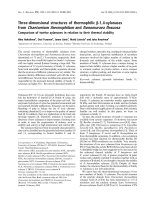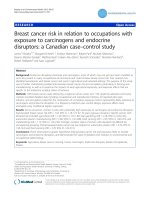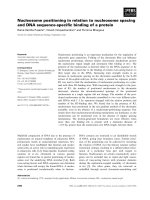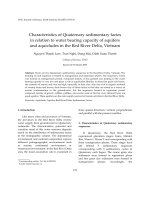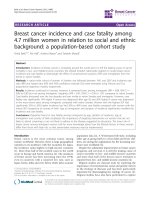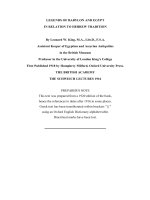Genetic predisposition and dietary factors in relation to adiponectin and insulin resistance
Bạn đang xem bản rút gọn của tài liệu. Xem và tải ngay bản đầy đủ của tài liệu tại đây (3.14 MB, 164 trang )
GENETIC PREDISPOSITION AND DIETARY
FACTORS IN RELATION TO ADIPONECTIN
AND INSULIN RESISTANCE
GAO HE
(BSc 1
st
Class Hons,
National University of Singapore)
A THESIS SUBMITTED FOR THE DEGREE OF
DOCTOR OF PHILOSOPHY
NUS GRADUATE SCHOOL FOR INTEGRATIVE SCIENCES AND
ENGINEERING, NATIONAL UNIVERSITY OF SINGAPORE
&
SAW SWEE HOCK SCHOOL OF PUBLIC HEALTH,
NATIONAL UNIVERSITY OF SINGAPORE
&
DEPT. OF MEDICAL EPIDEMIOLOGY AND BIOSTATISTICS,
KAROLINSKA INSTITUTET
2013
Declaration
I hereby declare that this thesis is my original work and it has been written by me in
its entirety. I have duly acknowledged all the sources of information which have been
used in the thesis.
This thesis has also not been submitted for any degree in any university previously.
_______________________
Gao He
15 Nov, 2013
ACKNOWLEDGEMENTS
The work in this thesis was conducted between 2009 and 2013 as a collaboration
between National University of Singapore (NUS) and Karolinska Institutet (KI) in
Sweden. I am very grateful to be given this opportunity to study in two countries of
different climate and culture, and to meet many great people that I would like to thank:
Rob van Dam, my NUS main supervisor, to whom my utmost sincere gratitude goes,
for guiding me along the way of my PhD and for supporting me to participate in this
joint PhD program. The efforts you have put into my projects and graduation issues are
tremendous, especially the long-distance communication during my days in Sweden. I
learned a lot from you, not only knowledge-wise, but also your scientific attitude.
Erik Ingelsson, my co-supervisor at KI, for taking me as a student at KI which
introduced a new chapter in my life. You have spent substantial amount of time
overseeing and working in detail on my studies, as well as providing guidance on my
personal development. You have done far more than the requirements for a co-
supervisor.
Sara Hägg, my co-supervisor at KI, for the day-to-day supervision and discussions on
my project work and the care for my life in Sweden. You are both a responsible
supervisor and a very nice friend. You are also someone special to me, because usually I
only switch to Swedish input when typing your name!
My Thesis Advisory Committee members at NUS: Chia Kee Seng, Tai E Shyong and
Teo Yik Ying, for following up my progress and guiding me for directions. Your
scientific expertise and research passion have also greatly motivated me.
Other members of the Ingelsson group at KI, including Jitender Kumar, Tove Fall,
Marcel den Hoed, Katherine Kasiman, Stefan Gustafsson, Andrea Ganna, Ci Song and
Manoj Bandaru, for making the group lovely and warm and for the scientific
interactions as well as fun activities we had together.
Salome Antonette Rebello, Nasheen Naidoo, Chen Lingwei, Sun Ye, Cynthia Chen
Huijun, Oi Puay Leng, Koh Wai Ling Hiromi, Zheng Huili, Nithya Neelakantan and all
the others from Rob’s nutrition meeting group at NUS, for your company on the way of
learning and for the inspiring discussions.
Peer students and postdocs from both sides (so many to name!!) whose friendship I
really treasure, for making EPH a nice memory in my heart and for the happy time over
lunch and fika at MEB.
My funding school NGS for the PhD scholarship and for supporting me in the 2+2
program.
Last but not least, my parents and my boyfriend, who have shared all my emotions −
happiness, excitement and transient depression, and have given me such strong support
during the whole course of my PhD study.
TABLE OF CONTENTS
1 Background 1
1.1 Diabetes 1
1.1.1 Prevalence of diabetes 1
1.1.2 Pathophysiology of the disease 2
1.2 Insulin resistance 3
1.2.1 Definition 3
1.2.2 Diagnostic tests 3
1.2.3 The role of obesity in insulin resistance and T2D 4
1.2.4 Ethnic differences 6
1.2.5 Dietary antioxidants 8
1.3 Adiponectin 10
1.3.1 Structure and circulating forms 10
1.3.2 Receptors and signaling pathways 10
1.3.3 Functions in glucose and fatty acid metabolism 11
1.3.4 Heritability and genetic predisposition 13
2 Aims of the thesis 15
3 Methods 16
3.1 Participants 16
3.1.1 The Singapore Prospective Study Programme (SP2) 16
3.1.2 The Uppsala Longitudinal Study of Adult Men (ULSAM) 17
3.2 Measurements 18
3.2.1 SP2 (Study I and II) 18
3.2.2 ULSAM (Study III and IV) 19
3.3 Genotyping 22
3.3.1 SP2 (Study II) 22
3.3.2 ULSAM (Study III) 23
3.4 Statistical analysis 23
3.4.1 Path analysis in Study I 23
3.4.2 Genome-wide association analysis in Study II 25
3.4.3 Mendelian randomization in Study III 26
3.4.4 Longitudinal analysis in Study IV 29
4 Results & Discussions 31
4.1 Study I 31
4.2 Study II 37
4.3 Study III 46
4.4 Study IV 52
4.5 Strengths and limitations 58
4.5.1 Strengths 58
4.5.2 Limitations 59
5 Conclusions 62
6 Future Perspectives 63
6.1 Clinical utility of adiponectin as a biomarker 63
6.2 Further characterization of the causality between adiponectin and insulin
sensitivity 64
6.3 Adiponectin as a therapeutic target in diabetes treatment 65
7 References 67
SUMMARY
Diabetes mellitus is a global health problem, owing to the high prevalence and
enormous associated economic burden. Insulin resistance is a critical condition to the
development of type 2 diabetes (T2D). Adiponectin, a hormone secreted by the adipose
cells, has attracted much attention for its insulin-sensitizing and anti-diabetic effects.
The overall aim of this thesis was to have a better understanding of the roles of
ethnicity, genetic variants and dietary factors in relation to adiponectin and insulin
resistance by means of different analytical approaches.
In Study I, using path analysis, we examined potential mediators including body fatness,
adiponectin levels, and inflammation for the extent they mediate the ethnic differences
in insulin resistance among Singaporean Chinese, Malays and Indians. General
adiposity explained the difference in insulin resistance between Chinese and Malays,
whereas abdominal fat distribution, inflammation, and unexplained factors contributed
to excess insulin resistance in Asian Indians as compared with Chinese and Malays.
In Study II, we carried out a genome-wide association study to identify genetic variants
that influence adiponectin levels in East Asian populations. The top signal from CDH13
explains a substantial part of variation in high-molecular-weight (HMW) adiponectin
levels, but its effect on circulating HMW adiponectin levels did not appear to translate
into effects on insulin-resistance related metabolic traits, suggesting that compensatory
mechanisms exist that lead to greater ‘adiponectin sensitivity’.
In Study III, the question whether changes in adiponectin levels causally influence
insulin sensitivity was addressed by a Mendelian randomization design in a cohort of
Swedish men. Genetically determined adiponectin levels influence euglycemic clamp-
measured insulin sensitivity to the same degree as the observed epidemiological
associations. Thus, the observed association between higher adiponectin levels and
increased insulin sensitivity is likely to represent a causal relationship.
In Study IV, we examined relations between serum selenium levels and measures of
glucose and insulin metabolism, as well as risk of T2D longitudinally in Swedish men.
There was no clear evidence of an effect of selenium status on various measures of
insulin sensitivity or β-cell function. Selenium levels were also not associated with risk
of T2D. These results do not support a role for selenium supplementation as a broad
approach for the prevention of T2D.
In conclusion, mediators of ethnic differences in insulin resistance differed markedly in
the Singaporean populations. In East Asians, CDH13 strongly influences adiponectin
levels and associates with a beneficial metabolic profile when controlling for circulating
adiponectin. Inferred from genetics, the positive relationship between adiponectin and
insulin sensitivity appears to be causal. There is no evidence of an effect of selenium
intake on glucose and insulin metabolism or risk of T2D in the Swedish population.
LIST OF PUBLICATIONS
*
Denotes equal contribution or joint direction of the project work
I.
Gao H, Salim A, Lee J, Tai ES, van Dam RM. Can body fat distribution,
adiponectin levels and inflammation explain differences in insulin resistance
between ethnic Chinese, Malays and Asian Indians? International journal of
obesity 2012;36(8):1086-93.
II.
Gao H, Kim YM, Chen P, Igase M, Kawamoto R, Kim MK, Kohara K, Lee J,
Miki T, Ong RT, Onuma H, Osawa H, Sim X, Teo YY, Tabara Y
*
, Tai ES
*
,
van Dam RM
*
. Genetic variation in CDH13 is associated with lower plasma
adiponectin levels but greater adiponectin sensitivity in East Asian
populations. Diabetes 2013;62(12):4277-83.
III.
Gao H, Fall T, van Dam RM, Flyvbjerg A, Zethelius B, Ingelsson E
*
, Hägg S
*
.
Evidence of a causal relationship between adiponectin levels and insulin
sensitivity: a mendelian randomization study. Diabetes 2013;62(4):1338-44.
IV.
Gao H, Hägg S, Sjögren P, Lambert P, Ingelsson E
*
, van Dam RM
*
: Serum
selenium in relation to measures of glucose metabolism and incidence of type
2 diabetes in an older Swedish population. Diabet Med. In press.
Other relevant publication not included in thesis:
Wu Y
*
, Gao H
*
, [46 authors], Mohlke KL
*
, Tai ES
*
: A meta-analysis of
genome-wide association studies for adiponectin identifies a novel locus near
WDR11-FGFR2 in East Asians. Hum Mol Genet 2013
LIST OF TABLES
Table 1. Risk factors for insulin resistance by gender and ethnicity in Study I.
Table 2. Associations between ethnicity and the HOMA-index of insulin resistance
based on linear regression analysis with and without adjustment for potential
intermediates.
Table 3. Characteristics of the study populations in Study II.
Table 4. Power for a genome-wide association study on adiponectin in SP2.
Table 5. Association between rs4783244 in CDH13 and different forms of adiponectin.
Table 6. ADIPOQ SNPs available on the Metabochip and their associations with serum
adiponectin.
Table 7. Instrumental variable estimated and observed association between adiponectin
and insulin sensitivity.
Table 8. Association of baseline serum selenium (at age 50) with adiponectin levels at
the age-70 follow-up.
Table 9. Association of baseline serum selenium (at age 50) with diabetes risk during
follow-up at age 60, age 70 and age 77 years.
LIST OF FIGURES
Figure 1. Design of the Singapore Prospective Study Programme.
Figure 2. Overall design of the Uppsala Longitudinal Study of Adult Men.
Figure 3. Full path diagram for the hypothetical model.
Figure 4. Hypothetical model for the relationship between ADIPOQ, adiponectin and
insulin sensitivity.
Figure 5. Path coefficients in the reduced models for pair-wise ethnic comparison of
differences in insulin resistance in men and women.
Figure 6. Manhattan plot (A) and Quantile-Quantile plot (B) for the whole-genome
association with HMW adiponectin in Singapore Chinese.
Figure 7. Effect estimates of rs4783244 in CDH13 on selected metabolic traits across
studies; age, sex and HMW adiponectin adjusted.
LIST OF ABBREVIATIONS
AAC acetyl coenzyme A carboxylase
AMPK 5'-adenosine monophosphate-activated protein kinase
BMI body mass index
CRP c-reactive protein
GPx glutathione peroxidase
GWAS genome-wide association study
HDL-C high-density lipoprotein cholesterol
HMW high-molecular-weight
HOMA-β homeostasis model assessment of β-cell function
HOMA-IR homeostasis model assessment of insulin resistance
HWE Hardy-Weinberg equilibrium
IV instrumental variable
IVGTT intravenous glucose tolerance test
LD linkage disequilibrium
MAF minor allele frequency
MR mendelian randomization
NEFAs non-esterified fatty acids
OGTT oral glucose tolerance test
PPAR peroxisome proliferator activated receptor
QC quality control
RBP4 retinol-binding protein 4
RCT randomized clinical trial
ROS reactive oxygen species
SNP single nucleotide polymorphism
SP2 the Singapore Prospective Study Programme
T2D type 2 diabetes
TNF-α tumor necrosis factor-α
TZDs thiazolidinediones
ULSAM the Uppsala Longitudinal Study of Adult Men
WHR waist-hip ratio
1 BACKGROUND
1.1 Diabetes
1.1.1 Prevalence of diabetes
Diabetes mellitus is one of the most common non-communicable diseases in the world
nowadays. It has three major types, namely type 1 diabetes, type 2 diabetes (T2D) and
gestational diabetes. T2D used to be called non-insulin dependent diabetes and accounts
for at least 90 percent of all diabetic cases. The global prevalence of diabetes by
International Diabetes Federation (IDF) was estimated to be 8.3% in 2011 and this
number is projected to reach 9.9% with a burden of 438 million individuals in 2030 [1].
The economic cost incurred is heavy and 471 billion USD were spent due to diabetes in
2012 [1], not to mention the indirect and intangible costs.
A remarkable feature is that developing countries now experience more serious situation
than developed countries, as 4 out of 5 people with diabetes live in low- and middle-
income countries. In addition, almost half of the global burden of diabetes now falls in
Asia, mainly due to large population size in China and India. The estimated number for
2011 was reported to be 92.4 million in China [2] and 62.4 million in India [3].
Moreover, T2D is often undiagnosed and according to the IDF statistics, 50% of the
people were unaware of their condition. Patients are usually only diagnosed due to
serious macrovascular and microvascular complications which include cardiovascular
diseases, kidney failure (diabetic nephropathy), neurological complications (diabetic
neuropathy) and eye diseases (diabetic retinopathy).
1
1.1.2 Pathophysiology of the disease
T2D is a disorder in glucose metabolism characterized by hyperglycemia. It results from
a combination of defects in insulin secretion and insulin action and is hallmarked by
resistance to effects of insulin in the liver, skeletal muscle and adipose tissues. As a
result, the pancreatic β-cells increase the release of insulin to compensate for the
reduced insulin action, until β-cell dysfunction occurs when the high demand cannot be
met.
The relationship between β-cell function and insulin sensitivity is nonlinear following a
hyperbolic shape and β-cells adapt to changes in insulin sensitivity by improved
functional responsiveness and an increase in volume/mass [4, 5]. The degree of
abnormality of insulin release by the β-cells proved to be the primary determinant of
differences in glucose tolerance between individuals. Moreover, β-cell function declines
progressively and the risk could be pre-existing, or genetically determined [4, 6].
Familial occurrences have been well known for diabetes [5]. The heritability of T2D
was estimated to be 26% [7] and so far, known genetic variants explained only <10% of
the estimated genetic contribution. Chronic over-nutrition and a failure to contain this
fuel surfeit is the primary cause for the development of T2D [8]. Overweight and
obesity are highly associated with risk of diabetes. However, many obese individuals
manage to maintain normal glucose levels and do not develop diabetes in their entire
life which implies the existence of interplay between genetics and environment.
Moreover, early-life environment could regulate fatal and neonatal programming
through epigenetic effects and hyperglycemic intrauterine environment is believed to
contribute to the pathogenesis of T2D [9, 10].
2
1.2 Insulin resistance
1.2.1 Definition
Insulin is secreted in the β-cells of the pancreatic islets of Langerhans in response to
elevated blood glucose levels after a meal. The major tissues insulin targets to lower
blood glucose levels include the liver, skeletal muscles and adipose tissue. Insulin
suppresses gluconeogenesis in hepatic cells and promotes glucose uptake in the
muscles and adipocytes. Insulin sensitivity measures the responsiveness of tissues to
insulin action and conversely, insulin resistance refers to a condition where the body is
less sensitive to the functions of insulin. As a result, high level of insulin is usually
observed under insulin-resistant condition.
1.2.2 Diagnostic tests
The gold-standard method to measure insulin sensitivity is the glucose clamp, or more
specifically, the hyperinsulinemic euglycemic clamp [11]. As the name suggests, in
this test insulin is infused at a constant high rate to reach a hyperinsulinemic status.
This stimulates glucose uptake in skeletal muscles and adipose tissue and suppressed
glucose production in the liver. Glucose is infused during the entire process in order to
keep glucose concentration at constant levels. At steady-state the glucose infusion rate
is assumed to equal glucose disposal rate which measures tissue sensitivity to
exogenous hyper insulin levels. However, this test requires sophisticated equipment
and is time-consuming and labor-intensive, and is thus rarely used in large
epidemiological studies.
There are indirect measures of insulin sensitivity based on dynamic tests. One of such
is the intravenous glucose tolerance test (IVGTT) and the most widely used method is
3
the minimal model analysis of frequently sampled intravenous glucose tolerance test
(FSIGT) [12]. FSIGT involves frequent blood samples for the measurement of glucose
and insulin concentrations, and is slightly less laborious than the clamp method. There
are also measures that are based on the oral glucose tolerance test (OGTT), a test
widely used in clinical settings. Some OGTT-derived indices for the assessment of
insulin sensitivity include the Matsuda index [13], the Stumvoll index [14], the Gutt
index [15] and the Belfiore index [16].
In large epidemiological studies, it is common to use simple fasting measures of blood
glucose and insulin concentrations to estimate insulin sensitivity and β-cell function.
The Homeostasis model assessment index of insulin resistance (HOMA-IR) [17] uses
simple equation to compute a surrogate index of insulin resistance based on steady-
state basal glucose and insulin concentrations. However, it correlated more weakly
with euglycemic clamp-measured insulin sensitivity, as compared with the OGTT-
derived indices [18].
1.2.3 The role of obesity in insulin resistance and T2D
Mammalian adipose tissues consist of white and brown adipose. The brown fat is
involved in thermogenesis and in human it is mainly found in newborn infants. Instead,
the white adipose tissue has an important role in maintaining whole-body glucose
homeostasis as well as lipid metabolism and adipocyte dysfunction is closely linked to
insulin resistance and T2D.
Since the discovery of leptin in 1994 [19], the adipose tissue is increasingly
recognized for its function as an endocrine organ. The white adipose tissue secretes
4
numerous cytokines and hormones collectively known as adipocytokines, or
adipokines [20]. Most of them, such as tumor necrosis factor-α (TNF-α), interleukin-6
(IL-6), leptin, retinol-binding protein 4 (RBP4) are pro-inflammatory, while
adiponectin (introduced in the next chapter) has a unique anti-inflammatory and
insulin sensitizing property [20-22]. This is important because chronic low-grade
inflammation has been implicated in obesity and insulin resistance. C-reactive protein
(CRP) is an acute-phase protein that serves as an important marker of systemic
inflammation and is also related to insulin resistance [23].
Hypertrophic adipocytes increase secretion of many adipokines including monocyte
chemoattractant protein-1 (MCP-1), also known as chemokine (C-C motif) ligand 2
(CCL2). MCP-1/CCL2 recruits additional macrophages which secretes large amount
of TNF-α, resulting in an inflammatory state [24]. Increased lipolysis and decreased
triglyceride storage lead to higher circulating levels of non-esterified fatty acids
(NEFAs) and triglycerides. This causes ectopic lipid accumulation and impairs
insulin-stimulated glucose uptake in skeletal muscle, which is believed to be a primary
cause of insulin resistance [25]. Similarly, excess fatty acids in the liver decrease the
responsiveness of the hepatic cells to insulin.
High levels of NEFAs may be the most critical determinant of insulin sensitivity. One
proposed mechanism [26] is that increased intracellular concentrations of fatty acid
metabolites, such as fatty acyl-coenzyme A (fatty acyl-CoA), diacylglycerol (DAG),
and ceramides lead to phosphorylation of insulin receptor substrates (IRS) at
serine/threonine site, and this disrupts the insulin signaling pathway by deactivating
5
the phosphatidylinositol 3–kinase (PI 3-kinase). As a result, downstream insulin
signaling and glucose transport is compromised.
Fat distribution is another important contributor of insulin resistance and abdominal
obesity is closely associated with adverse metabolic consequences [27, 28]. Visceral
adipose tissue is more lipolytic and less insulin-sensitive than the subcutaneous
adipose tissue [29]. Together with the fact that the visceral fat depot is in closer
proximity to the liver, portal NEFA levels are elevated in abdominal obesity. The
expected results are increased hepatic glucose production and peripheral
hyperglycemia [30].
1.2.4 Ethnic differences
Marked differences in insulin resistance exist between ethnic groups [31]. At the same
degree of body fatness, whites have been consistently observed to have the lowest level
of insulin resistance among major ethnic groups in the world [32-34].
Focusing on Asia where the burden of T2D is the heaviest, Asians, and particularly
Asian Indians, are more insulin resistant than whites for a given degree of adiposity
[35]. For the same body mass index (BMI), Asian Indians tend to have a higher level of
body fat than whites [36] and they were more insulin resistant than whites for the same
level of total body fat [37, 38], likely contributed by their abdominal fat distribution [39-
41], differences in adipocyte cell size [38] and a higher ratio of total body fat to lean
mass [37]. In addition, lower adiponectin levels [31, 32, 34, 42-44], higher CRP levels
[44-46] as compared with whites independent of BMI, and dietary factors may
contribute to the higher susceptibility of Asian Indians in developing T2D [47, 48].
6
Several studies in the U.S. have also demonstrated greater insulin resistance in East
Asians as compared with whites for a given BMI [33, 49, 50]. For example, Chinese-
American and Japanese-American women were more insulin resistant than white
women after adjusting for waist circumference [49]. Asian Americans have also been
shown to be more likely to develop T2D than whites after adjustment for BMI [51].
Lower adiponectin levels in East Asians than BMI-matched whites, as reported for
Japanese men [52] and for Koreans men and women [53], may contribute to these
ethnic differences in insulin resistance and T2D. In a Canadian study, Chinese had
lower adiponectin levels than whites in both men and women after considering
differences in waist circumference [31].
There is also evidence for substantial differences in insulin resistance between ethnic
groups in Asia. Asian Indians are more insulin resistant and glucose intolerant than
Chinese and Malays [54], but reasons for these ethnic differences are not well
understood. One of the major contributing factors could be adiposity and fat
distribution, as Asian ethnic groups differ from each other in body composition [55].
However, this does not fully explain the ethnic difference in insulin resistance. In
Singapore, for example, Malays have the highest levels of adiposity, but not the highest
levels of insulin resistance [54]. Circulating adipokines and inflammatory markers may
contribute to some of the differences in insulin resistance between Asian ethnic groups,
but to what extend these factors mediate the relation between ethnicity and insulin
resistance independently and inter-connectively remains largely inconclusive.
7
1.2.5 Dietary antioxidants
Oxidative stress manifests an imbalance between the production of reactive oxygen
species (ROS) and antioxidant defenses [56]. Increased ROS levels and excessive
oxidative stress trigger insulin resistance, impair glucose tolerance and β-cell function,
and accelerate the development of T2D [57-59]. Some of the most recognized dietary
antioxidants include vitamin C, vitamin E, selenium and carotenoids.
A meta-analysis showed that the intake of antioxidants was associated with 13%
reduction in the risk of T2D and this was mainly attributed to vitamin E and
carotenoids [60]. Several longitudinal studies have found that dietary β-carotene (a
subtype of carotenoids) and α-tocopherol (a subtype of tocopherol, or vitamin E)
independently predicted risk of T2D [61-63], possibly mediated by an improvement in
insulin sensitivity [63]. However, supplementation of β-carotene and α-tocopherol in
randomized clinical trials (RCTs) revealed no benefit in the prevention of T2D and
indicated that the relationship may not be causal [60].
Flavonoids are compounds with anti-oxidant capacities. A recent large prospective
study found an association between consumption of foods rich in anthocyanin (a sub-
class of flavonoids), especially berries and apples/pears, and a lower risk of T2D[64].
In contrast to anti-oxidants, excess iron is believed to elicit toxic effects mainly related
to oxidative stress, due to the generation of ROS during a redox cycle [65]. High body
iron store, as reflected by serum ferritin levels, has been associated with increased risk
of T2D and it was suggested that dietary iron caused insulin resistance through down-
regulation of adiponectin [66, 67].
8
Selenium
Selenium is an essential trace mineral. It exists predominantly as selenocysteine and
selenomethionine in foods, but the content varies greatly depending on the soil
conditions. Selenocysteine (Se-Cys) is a cysteine analogue with a selenium-containing
selenol group replacing the sulfur-containing thiol group. Proteins that include a
selenocysteine amino acid are called selenoproteins. The most abundant selenoprotein
in the plasma is selenoprotein P [68, 69]. Glutathione peroxidases (GPx) is a family of
enzymes with peroxidase activity that detoxify peroxides and hydroperoxides. They
are involved in antioxidant defense and protect against oxidative stress. GPx are also
selenoproteins accounting for 10-30% of plasma selenium [68] and it contains
selenium as selenocysteine in the catalytic site.
Selenium has been suggested to have insulin-mimetic and anti-diabetic properties [70,
71], but results from existing studies on its association with risk of T2D are inconclusive
[71]. In cross-sectional studies, higher selenium status has been associated with both a
lower and a higher prevalence of diabetes [72-74]. Most RCTs concluded no overall
efficacy of selenium supplementation on risk of diabetes and glucose control [75-77].
Importantly, selenium supplementation in clinical trials is usually given in high doses
and effects may thus not reflect effects of smaller variation in dietary selenium intakes.
To date, little evidence is available from prospective cohort studies of selenium status in
relation to glucose tolerance and risk of diabetes. In addition, there is a lack of studies
studying selenium intake in relation to detailed measures of insulin processing, secretion
and sensitivity.
9
Selenium content in foods varies greatly depending on soil conditions and as a result,
selenium intakes calculated using food composition databases are inaccurate. In
contrast, serum/plasma selenium is a reliable biomarker for selenium status [78, 79].
The correlation between serum selenium and selenium intake has been shown to be
reasonably high [80]. Besides, erythrocyte selenium and toenail selenium are good
measures of long-term selenium intake.
1.3 Adiponectin
1.3.1 Structure and circulating forms
Adiponectin is a 30-kDa protein secreted by the adipocytes. It is the most abundant
adipokine in the circulation and its levels remain relatively constant [81, 82]. The
protein is composed of four domains: an N-terminal signal peptide, a variable region, a
collagenous domain, and a C-terminal globular domain. Adiponectin exists in full-
length as multimer complexes, and also as a globular fragment. The three major
oligomeric forms include the low-molecular-weight (LMW) trimer, the middle-
molecular-weight (MMW) hexamer and the high-molecular-weight (HMW) 12-18mer
[83]. The different isoforms could have distinct properties and exert diverse biological
functions, although this is not completely understood yet. Therefore, multimer
distribution, in addition to total adiponectin concentration, should also be considered in
the interpretation of adiponectin levels and health outcomes [84].
1.3.2 Receptors and signaling pathways
Three adiponectin receptors are known to date. Adiponectin receptor 1 (AdipoR1) and
adiponectin receptor 2 (AdipoR2) are transmembrane receptors having an inverse
topology as compared with the G protein-coupled receptors [85]. A third receptor, T-
10
cadherin, belongs to the cadherin family of proteins and has not been well-characterized
for its function with adiponectin. It lacks an intracellular domain and is attached to the
membrane by a glycosylphosphatidylinositol (GPI) anchor [86].
AdipoR1 binds to globular adiponectin with high affinity and AdipoR2 has intermediate
affinity for both globular and full-length adiponectin [85]. Both receptors are
abundantly expressed, although the relative abundance varies in tissues. T-cadherin is a
receptor exclusively for hexameric and HMW adiponectin [86] and is expressed in the
endothelial and smooth muscle cells [87].
Adiponectin mainly signals through the adenosine monophosphate (AMP)-activated
protein kinase (AMPK) and the peroxisome proliferator activated receptor-α (PPAR-α)
signaling pathways [88, 89]. However, individual isoforms seem to have different
biological activities and activate different signal transduction pathways. In skeletal
muscle, trimeric adiponectin activates AMPK, whereas the hexamer and HMW form
activate NF-kB pathway [90]. In the liver, AMPK are stimulated by full-length
adiponectin only [88]. Therefore, it is possible that adiponectin controls its ligand
signaling by different oligomerization states. Without an intracellular domain, T-
cadherin is thought to have no role in signal transduction, although it is capable of
binding adiponectin.
1.3.3 Functions in glucose and fatty acid metabolism
Although adiponectin is primarily produced by the adipose tissue, as a paradox, blood
levels of adiponectin are inversely associated with obesity [91]. In addition, a sexual
dimorphism is observed where adiponectin levels are higher in women than in men, but
11


